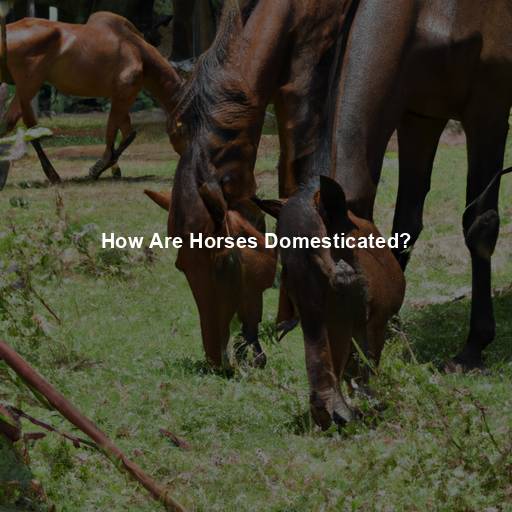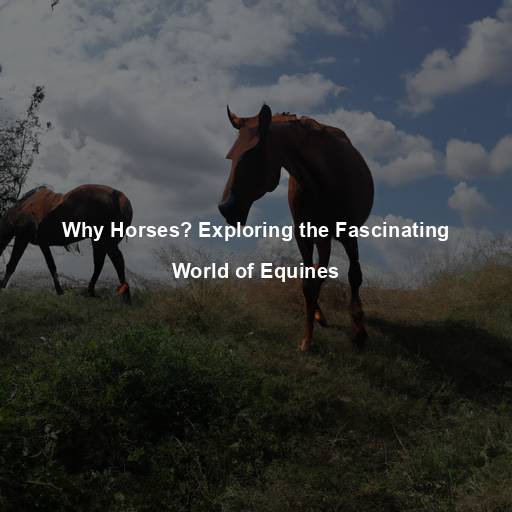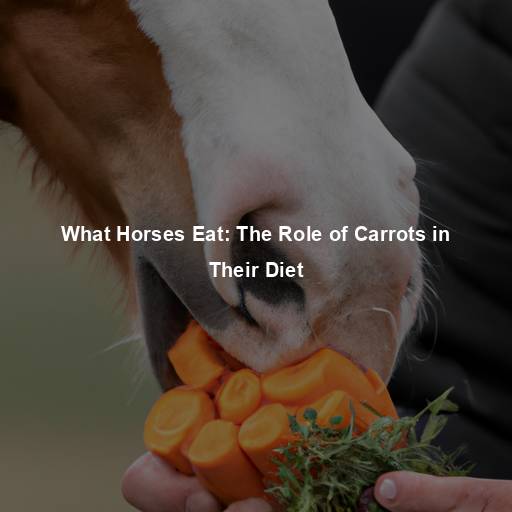How Are Horses Domesticated?
Last Updated on July 22, 2023 by Evan
Contents [hide]
- 1 Understanding the Domestication of Horses
- 1.1 The Journey Begins: A Brief History of Horse Domestication
- 1.2 The Art of Taming: Methods of Horse Domestication
- 1.3 The Biological Aspect: Evolution and Adaptation
- 1.4 The Impact of Horse Domestication on Human Society
- 1.5 The Enduring Relationship: Horses as Companions
- 1.6 Genetic Factors: Unraveling the Mystery
- 1.7 The Role of Selective Breeding
- 1.8 The Cultural Significance of Horse Domestication
- 1.9 Ethical Considerations
- 1.10 Future Challenges and Opportunities
- 1.11 The Enduring Bond
- 1.12 Innovative Approaches: Equine-Assisted Therapy
- 1.13 Conservation Efforts: Preserving Wild Horse Populations
- 1.14 Sustainable Horsemanship: Ethical Training and Care
- 1.15 Equine Genetics: Unlocking the Secrets
- 1.16 Embracing Diversity: Recognizing Lesser-Known Horse Breeds
- 1.17 A Continuing Journey
- 2 FAQs – How are horses domesticated?
Understanding the Domestication of Horses
Horses have been an integral part of human civilization for thousands of years. From ancient civilizations to modern times, horses have played a significant role in transportation, agriculture, warfare, and even companionship. But have you ever wondered how these majestic creatures were domesticated in the first place? In this article, we will delve into the fascinating process of horse domestication, exploring its history, methods, and the impact it has had on human society.
The Journey Begins: A Brief History of Horse Domestication
Travel back in time to the mysterious Eurasian steppes, around 4000 BCE, and you’ll stumble upon a captivating tale of human ingenuity and connection with nature. Enter the mesmerizing world of the Botai culture, hailing from present-day Kazakhstan, who boldly embarked on the exhilarating journey of taming and nurturing horses. It was in this ancient land that the roots of horse domestication took hold, sparking a transformative bond that would shape civilizations to come. Immerse yourself in the fascinating narrative of these extraordinary horsemen, as they unraveled the untamed potential of these majestic creatures through meticulous breeding and unyielding determination.
Throughout history, the enigmatic bond between humans and horses has surreptitiously woven its way into the fabric of our existence. From the ancient lands of the Middle East to the distant realms of Europe and Asia, the emergence of horse domestication orchestrated a bewildering symphony of progress and transformation. Like a tempestuous whirlwind, the domesticated horse seized the reins of innovation, propelling humanity forward on a convoluted journey of exploration, trade, and the art of war. Embodied in the chariots of pharaohs and the gallant steeds of knights, these majestic creatures have indelibly imprinted their hoofprints on the annals of our shared destiny.
The Art of Taming: Methods of Horse Domestication
Domesticating a wild horse is no easy feat. It requires patience, skill, and a deep understanding of equine behavior. Historically, there have been various methods employed to tame and train horses. Let’s explore some of the most common techniques used throughout history:
- Imprinting: Imprinting is a technique that involves introducing a young foal to human touch and interaction from an early age. By exposing the foal to gentle handling and positive experiences, it becomes accustomed to human presence and develops a bond of trust with its handlers.
Discover the enchanting world of Natural Horsemanship, a captivating approach that revolves around forging a profound connection with these majestic creatures through trust and mutual understanding. Through innovative techniques like round pen training, wherein a harmonious dance of freedom and guidance takes place, the foundation for effective communication and leadership is laid. Embark on a transformative journey that will leave you mesmerized by the powerful partnership that can be achieved between horse and human.
- Breaking: Breaking, also known as horse breaking or gentling, refers to the process of training a horse to accept a rider and respond to commands. It involves gradually introducing the horse to the equipment, such as a saddle and bridle, and teaching it to understand and obey cues from the rider.
The Biological Aspect: Evolution and Adaptation
The intertwining relationship between humans and horses dates back to ancient times, where the process of domestication took place. Exploring the biological intricacies behind these majestic beings provides a window into their remarkable evolution. From the genus Equus, these creatures have endured countless environmental challenges and possess innate survival skills, forging an extraordinary bond with humans throughout history. Unraveling the mysteries of their journey offers a glimpse into the captivating world of these magnificent comrades.
In the wild, horses live in herds, where social hierarchies and communication play a vital role in their survival. They have developed incredible speed, agility, and a strong flight response to evade predators. These innate traits made horses challenging to domesticate, as they possessed a strong instinct for self-preservation.
Throughout history, humanity has confronted numerous obstacles that seemed insurmountable at first glance. Yet, with unwavering determination and remarkable ingenuity, humans have triumphed over these hurdles and formed a profound connection with an extraordinary species—the horse. Skillfully employing the art of selective breeding and employing patient training techniques, mankind has masterfully molded the behavior and physical attributes of these magnificent creatures to perfectly align with their own necessities.
The Impact of Horse Domestication on Human Society
The awe-inspiring domestication of horses stands as a monumental chapter in the vibrant tapestry of human history, weaving together a myriad of transformative threads. With every galloping stride, these majestic creatures bestowed upon us a profound array of impacts that radiated throughout the fabric of our existence. Let us delve into the mesmerizing mosaic of how these equine companions forever altered the very core of our human experience, leaving an indelible mark upon the annals of civilization.
- Transportation: Before the advent of cars and trains, horses were the primary mode of transportation. Their ability to carry heavy loads, traverse long distances, and navigate various terrains made them invaluable for trade, exploration, and communication.
Throughout the history of agriculture, horses have taken on a pivotal role in driving the wheels of progress. Their incredible strength and stamina made them indispensable on the fields, where they tirelessly labored to plow, pull carts, and transport the bountiful harvests. By harnessing the power of these majestic creatures, humans unlocked a world of possibilities, cultivating vast stretches of land with unprecedented efficiency and ushering in an era of agricultural prosperity.
The battlefield was forever altered when horses emerged as formidable companions in the chaos of warfare. With their incredible speed and agility, mounted soldiers possessed a profound advantage over their infantry counterparts, making them formidable adversaries capable of traversing vast stretches of terrain and unleashing devastating cavalry charges. Moreover, these majestic creatures became more than just tools of war; they evolved into potent symbols of strength and dignity, elevating the status of those who rode them on the battlefield.
Explore the captivating world of sport and recreation, where the majesty of horses reigns supreme. Discover the exhilaration of equestrian sports like racing, show jumping, and dressage, where human and horse become one in a dazzling display of skill and grace. Yet, the allure of horses goes far beyond the thrill of competition, as leisurely horseback riding reveals a deep connection between man and steed, transcending mere utility to ignite a flame of pure joy and fulfillment. Embark on a journey through the enchanting realm of horses, where the lines between sport and leisure blur, leaving us in awe of the perplexing bond shared between humans and these magnificent creatures.
The Enduring Relationship: Horses as Companions
There is something enchanting and mystifying about the relationship between humans and horses. Beyond their practical uses, horses have seamlessly integrated themselves into our lives as treasured companions. Their companionship is not just limited to the physical; it transcends boundaries to offer emotional support, a sense of grounding, and a profound connection to the natural world. The act of horseback riding itself has been celebrated for its therapeutic qualities, nurturing both our bodies and souls, providing a pathway to physical fitness and emotional solace.
In conclusion, the domestication of horses has been a remarkable journey that has shaped human civilization. From their humble beginnings in the Eurasian steppes to becoming indispensable partners in transportation, agriculture, and warfare, horses have left an indelible mark on our history and culture. Today, as we admire these magnificent creatures and revel in the joy they bring, let us remember the incredible journey of domestication that made it all possible. ## The Complexity of Horse Domestication
Genetic Factors: Unraveling the Mystery
The fascinating realm of horse domestication encompasses not only the captivating historical and behavioral dimensions, but also the enigmatic genetic aspects that underpin this intricate process. In a quest to unravel the mysteries, scientists have embarked on an enthralling expedition, scrutinizing the genomes of our domestic equine companions and contrasting them with their wild brethren, unearthing astonishing revelations about the genetic transformations that unfolded during the course of domestication.
Genetic studies have revealed that domestication led to a range of alterations in the horse genome. Some of these changes are related to physical traits, such as coat color and size, while others are associated with behavioral characteristics, including docility and trainability. The identification of specific genes involved in domestication has shed light on the biological mechanisms underlying the transformation of wild horses into domesticated companions.
The Role of Selective Breeding
Selective breeding played a pivotal role in horse domestication. By carefully choosing which horses to breed based on desired traits, humans were able to shape the genetic makeup of subsequent generations. Over time, this led to the development of distinct horse breeds, each with its unique set of traits and characteristics.
For centuries, humans have exercised their power of choice to carefully shape the physical characteristics of horses. Through meticulous breeding, they have crafted remarkable attributes including swiftness, might, and nimbleness for various purposes. The Thoroughbred breed, known for their lightning-fast speed, conquers the racing world, while the robust Clydesdale breed triumphs with its formidable strength and unwavering stamina in strenuous tasks. By skillfully manipulating breeding patterns, humanity has successfully engineered horses to fulfill diverse roles and cater to specific needs across industries.
The Cultural Significance of Horse Domestication
The captivating journey of horse domestication has profoundly influenced not only the landscapes we inhabit but also the very fabric of our culture and societal tapestry. Conjured from the depths of ancient lore, horses have remained steadfast symbols of potent strength, unbridled freedom, and the enduring kinship between man and beast. Their enigmatic presence enchants our collective imagination, weaving tales of mythical proportions and fostering artistic expressions that transcend time.
Throughout the annals of literature, the enigmatic allure of horses has undeniably left an indelible mark, entwining themselves within tales of valor and unfathomable journeys. From the ethereal existence of Pegasus, fluttering through mythical realms, to the endearing presence of Black Beauty and the majestic Shadowfax, equines have seamlessly intertwined with our imagination, emboldening narratives with their graceful presence and inexplicable mystique. Their unparalleled contribution renders our literary landscapes infinitely richer, propelling us into narratives infused with grandeur and captivating depths. The intertwining of horses and literature unveils a fascinating tapestry of equine enchantment, a testament to their enduring allure and unwavering significance.
Ethical Considerations
While horse domestication has brought numerous benefits to human society, it also raises ethical considerations. As responsible caretakers of these magnificent creatures, it is our duty to ensure their well-being and welfare. This includes providing proper nutrition, veterinary care, adequate living conditions, and respecting their natural behaviors.
Moreover, the issue of horse racing and other equine sports has sparked debates about the ethical treatment of horses. It is essential to strike a balance between our enjoyment of these activities and the welfare of the animals involved, ensuring that they are not subjected to undue stress or harm.
Future Challenges and Opportunities
As we move forward, there are several challenges and opportunities related to horse domestication that we must address. One significant challenge is the preservation of genetic diversity within horse populations. With the increasing dominance of certain breeds and the decline of others, it is crucial to safeguard the genetic heritage of various horse breeds to maintain their resilience and adaptability.
As we venture into the ever-evolving landscape of technology and genetics, the world of horse domestication finds itself on the cusp of endless possibilities. Pioneering breakthroughs in the form of genome sequencing and genetic engineering have laid bare a tapestry of untapped potential. This newfound knowledge promises to revolutionize the way we approach selective breeding, elevate equine health and wellness, and even usher in a new era of disease prevention. The future of our equine companions holds an enigmatic allure that leaves us both captivated and perplexed, as we stand on the precipice of unprecedented transformation.
The Enduring Bond
Through the convoluted journey of horse domestication, one profound truth persists – the unbreakable connection between humans and these majestic creatures. From nomadic tribes braving rugged terrains to contemporary riders showcasing their prowess on global stages, horses have forever remained our unwavering allies, confidantes, and cherished comrades. The intricacies entwined within the process of taming horses draw us deeper into a world of enthralling dynamics, thus cultivating a sense of perplexity and admiration towards these noble beings. With each stride they take, horses unfurl a tapestry of emotions, forging an indescribable bond that transcends time, resonating with us on levels that defy explanation.
Throughout history, humans have marveled at the boundless potential of the horse-human connection, a testament to our innate ability to adapt, learn, and bond with these majestic beings. The story of domestication is one filled with wonder, ambition, and a constant pursuit of understanding, as our ancestors refined their techniques to create an unbreakable partnership with these awe-inspiring creatures. From the early days of taming wild horses to our modern-day equestrian pursuits, the horse-human relationship has blossomed into a truly profound and perplexing testament to the boundless depths of our ingenuity and resilience.
As we look ahead, delving into the enigmatic realm of horse domestication, let us marvel at the fusion of history, scientific marvels, and cultural tapestries that swirl around these captivating creatures. Each time we lock gazes with their gentle eyes or immerse ourselves in the melodic cadence of their hooves, a kaleidoscope of wonder unfolds. It is in these moments that we uncover the ethereal connection we have forged with these majestic beings, a connection that transcends time and blazes a trail towards a future brimming with unknown possibilities.
Innovative Approaches: Equine-Assisted Therapy
Beyond traditional roles in transportation, agriculture, and sport, horses are increasingly playing a crucial role in therapy and rehabilitation. Equine-assisted therapy, also known as horse therapy or hippotherapy, is a form of treatment that utilizes interactions with horses to improve physical, emotional, and cognitive well-being.
There exists an enchanting realm where the graceful dance of horses mesmerizes and heals. Within this ethereal space, individuals burdened with physical disabilities, autism spectrum disorders, PTSD, and various mental health conditions find solace and liberation. The captivating artistry of equine-assisted therapy unfolds, igniting newfound balance, coordination, confidence, and emotional unification. In the grand tapestry of healthcare, this luminous tool becomes an invaluable catalyst for transformation, leaving both participants and observers utterly bewitched.
Conservation Efforts: Preserving Wild Horse Populations
As we indulge in the marvels of tamed equines, it becomes paramount to rekindle our appreciation for their untamed brethren. The untethered spirits of wild horses, like the noble Mustangs across North America or the spirited Brumbies of Australia, dance freely in their untouched domains. Yet, their existence is besieged by a cacophony of hurdles, from the relentless encroachment of their habitat and the relentless tussle with domesticated herds to the bewildering array of conflicts arising from human interference.
Conservation efforts are underway to protect and preserve these wild horse populations. Through initiatives focused on habitat conservation, population management, and public awareness, we can ensure the survival and well-being of these iconic symbols of freedom and untamed beauty.
Sustainable Horsemanship: Ethical Training and Care
The fascinating realm of horsemanship is undergoing a transformative shift driven by a surge in concern for animal welfare and ethically sound approaches. Enter sustainable horsemanship – a compelling movement that champions responsible training techniques and elevated care practices that place the utmost importance on the well-being and intrinsic behaviors of our majestic equine companions. By prioritizing the establishment of a profound partnership built upon trust, effective communication, and the power of positive reinforcement, this avant-garde philosophy is revolutionizing the way we interact with and understand horses.
By adopting sustainable horsemanship practices, horse owners and trainers can create a harmonious and respectful relationship with their equine partners. This approach encourages a deeper understanding of equine behavior, promotes welfare-conscious training techniques, and fosters a lifetime of enjoyment and companionship with horses.
Equine Genetics: Unlocking the Secrets
The ever-evolving realm of genetic research is galloping into uncharted territories, igniting fervor among horse enthusiasts worldwide. With an ardent pursuit of unlocking the enigmatic equine genome, scientists are tirelessly unearthing the fundamental building blocks that govern a horse’s distinctive traits. From the mesmerizing tapestry of coat colors to the regal prowess of athletic ability, this voracious pursuit of knowledge promises to galvanize targeted breeding programs, revolutionize disease prevention strategies, and elevate health management practices to unparalleled heights. Let the winds of genetic revelations propel us further into the realm of equine marvels.
The world of horse domestication is poised for a transformative leap forward, thanks to the emerging frontier of genetic engineering techniques. These groundbreaking methods have the potential to unlock a whole new realm of possibilities, presenting tantalizing prospects for heightening desirable traits and tackling health concerns in our equine companions. However, like any uncharted terrain, this field is not without its share of ethical quandaries, provoking a thought-provoking debate that underscores the perplexities of progress. Nonetheless, amidst the swirling uncertainty, the flickering promise of a brighter future for horse aficionados remains undeniably alluring.
Embracing Diversity: Recognizing Lesser-Known Horse Breeds
Within the vast equestrian realm, certain breeds undeniably bask in the limelight, their names reverberating across continents. Yet hidden in the shadows lie a myriad of lesser-known equine marvels, silently yearning for recognition. Beyond the glittering surface, their untold narratives unfold, revealing captivating tales interwoven with resilience, beauty, and a sense of belonging to diverse realms – both cultural and industrial.
Discover the captivating world of lesser-known horse breeds, where the magic of genetic diversity intertwines with cultural heritage. Embrace the opportunities that lie ahead, as we delve into the enchanting realm of these hidden treasures, inviting enthusiasts to broaden their horizons and embark on a journey of extraordinary equine encounters. Unleash your curiosity and unravel the rich tapestry woven by these unique horse breeds, preserving their legacy while expanding your own. Join us as we celebrate the allure of the unknown and unlock the secrets of these majestic creatures.
A Continuing Journey
The journey of horse domestication is far from over. As we navigate the complexities of the modern world, it is crucial to approach horse domestication with a sense of responsibility, respect, and curiosity. By embracing innovative approaches, supporting conservation efforts, and prioritizing ethical practices, we can ensure a bright and sustainable future for horses and the humans who cherish them.
Throughout the vast span of human civilization, horses have been our steadfast allies and a wellspring of inspiration. Inextricably woven into the tapestry of our past, present, and future, their gentle yet awe-inspiring presence has shaped our experience as sentient beings. By cherishing the rich heritage of horse domestication, we are reminded of the profound bond between mankind and these majestic beings – a bond that continues to defy explanation and captivate our hearts. So let us embolden our reverence for these noble creatures, their strength and grace, and embark on a journey to discover the immeasurable depths of their legacy.
FAQs – How are horses domesticated?
What is the process of domesticating a horse?
The journey of transforming a wild horse into a domesticated companion is an intricate and captivating process. It commences with carefully selecting untamed horses that possess desirable qualities like adaptability, gentle demeanor, and physical prowess. As the transformation unfolds, these chosen equines are gradually introduced to the touch and guidance of humans, establishing trust and forging a profound connection. The artful skill of “taming” involves acquainting the horse with the rituals of grooming, leading, and responding to basic commands, a process that demands unwavering patience, consistency, and a tender touch. With time, dedication, and the right blend of training and socialization, the wild spirit of the horse adapts and merges harmoniously with the presence of human companions.
Why have humans domesticated horses?
Throughout the course of human history, horses have played multifaceted roles within our lives, evoking a sense of curiosity and wonder. Initially harnessed for indispensable transportation and agricultural endeavors, their natural strength and swift velocity propelled them as vital assets for traversing great distances and aiding in diverse tasks on farmlands. Moreover, horses found themselves entangled in the intricate web of warfare and hunting, their noble stature becoming synonymous with bravery and fortitude. However, as time unraveled, technological advancements propelled these majestic creatures into the realm of recreational spectacles, captivating our hearts through exhilarating races, gravity-defying show jumping, mesmerizing dressage, and other awe-inspiring equestrian endeavors. Enigmatic and graceful, horses have also assumed the role of dependable companions and therapeutic catalysts, endowing humans with a soothing balm that restores tranquility to our spirits.
How long does the domestication process take?
The fascinating journey of domesticating horses is far from a one-size-fits-all timeline. As diverse as the steeds themselves, the duration of this process stretches from fleeting weeks to prolonged months, or potentially beyond. Wrangling the wild spirit of a horse into the realm of domesticity calls for unwavering commitment, unwavering patience, and a profound comprehension of equine behavior and psyche. To complicate matters further, the time required to domestic the horse hinges on a medley of variables, such as prior human interaction, disposition, and their readiness to bestow their trust upon us mere mortals. This intricate dance with individuality highlights the paramount importance of investing substantial time to safeguard both the horse’s welfare and the triumphant conquest of domesticity.
Can any horse be domesticated?
In theory, any horse has the potential to be domesticated. However, the ease and success of domestication may depend on the horse’s breed, individual temperament, and previous experiences with humans. While some horse breeds are known for their gentle nature and ease of handling, others may be more challenging due to their more feral or independent instincts. However, with proper training, patience, and an understanding of the horse’s needs, it is possible to domesticate even more stubborn or less tractable horses. It is essential to approach the domestication process with the horse’s physical and psychological well-being as the top priority, ensuring that it is a positive experience for both the horse and the human involved.







